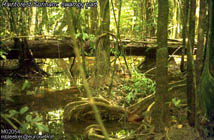





© Marco Bleeker, 1995-1998
On Earth, water occurs in three physical states: solid (ice), liquid, and gas (vapor). Its most common state is liquid as oceans, rivers, lakes and ponds. It is also present in much smaller quantities in organisms and soil. The water cycle operates within a rigorous balance, but is related to many factors associated with climate, vegetation cover, wind conditions, and the geographical location of large bodies of water such as rivers and lakes.
Water is an essential component of metabolic activities and acts as a primary transportation medium for both organic and inorganic substances. In plants it is fundamental to structural maintenance and in animals it is important to thermal regulation.
Water vapor is found in the atmosphere and is created by evaporation, mainly from bodies of liquid water, but also from the soil and by plant transpiration; and to a minor extent through respiration, excretion and perspiration processes in animals. After the organism's death, water comes back to the environment through decomposers' action. The energy source for this is mainly solar radiation. Tree cover - such as the rainforest canopy - and vegetation (including seaweed) can play a major part in regulating rates of evaporation. Cloud cover is created by the evaporation process as a result of phase changes in the water, due to alterations in pressure and temperature.
Plants absorb ground water through their roots and the consumers (ie animals) absorb it directly by drinking, or indirectly through the consumption of plants and other animals.
Go
to
Home
| Space Station
| Mars | Rainforest
© 1999 Satellite Events Enterprises Inc.